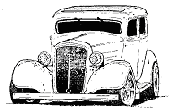1929 Ford "Silver Bullet" Roadster (Boyd Coddington)
Est. 300 bhp, 350 cu. in. Chevrolet V8 engine, four-barrel carburetor, custom dropped front tubular axle with torsion bars, Corvette independent rear suspension with coil-over shocks, front disc and rear drum brakes. Wheelbase: 102"
The late Boyd Coddington was a crack machinist at Disneyland in the early 1970s. A budding hot rod builder, he was searching for a unique style and a personal statement. Boyd’s first cars were heavily influenced by his friend, “’Lil” John Buttera, a former race car builder, and a clever craftsman, who was one of the first hot rodders to use CNC machines to create and literally ‘carve’ custom engines and suspension parts from chunks of billet aluminum. Ever the minimalist, with a race car builder’s love of simplicity and function, Buttera reduced complex forms and components to their basic elements. He deplored fussiness and excess, and his work often resembled sculpture rather than a combination of mechanical elements
Coddington greatly admired a contemporary-looking ’27 Model T Ford sedan that Butera had built, and he responded with a similar ’26 T. Butera’s next project was an ultra-modern ’29 Ford Model A roadster, which in turn inspired Coddington to create a counter-car that would become known as the “Silver Bullet.” Street Rodder magazine aptly called it, “a striking blend of traditional styling, contemporary rodding and innovation.” For the “Bullet,” Buttera fashioned a smooth frame that complemented the contours of the classic Model A roadster body. Modern windshield posts framed a sheet of glass that was left uncapped at the top. Boyd filled all the body seams, smoothed the rear fender wells, and fabricated an independent rear end using a Corvette center section and J&J hub carriers.
Custom slotted billet wheels with large, artistically-shaped center hubs, handmade hairpin wishbones, a beautifully-crafted dropped front axle, a “Bulldog” style abbreviated front end with no frame horns, and functional lever shocks comprised the front section. Boyd hand-shaped a beautiful three-piece hood, louvered the side panels, then mated it to a Model A grille shell that was devoid of any badges and a filler cap. The headlights appeared to ‘float’ alongside the grille. The taillights were impossibly thin Lucite strips. Totally modern, clean and contemporary, it made retro-style Model A highboy roadsters look positively ancient.
In keeping with this car’s clean exterior, Jim Bailey created an understated burgundy leather interior; Steve Borowitz added a woodgrain dash insert, which Buttera filled with then-contemporary digital gauges. A wood-rimmed three-spoke steering wheel complemented the dash. The shift lever was a turned billet creation. Even the pedals were billet. There was nothing visible on this car that could be considered excess.
The “Silver Bullet” was featured on the cover of Street Rodder magazine in April 1978. This car’s simplistic elegance spoke for itself, so the article text was unusually light. The magazine didn’t have to say very much; this car said it all. Vern Luce, a wealthy would-be patron, saw the Model A and retained Boyd to build him a ’33 Ford coupe that would soon draw national acclaim. With this commission, Coddington quit his machinist job at Disneyland and opened his own shop.
When the completed Vern Luce coupe appeared in 1981, it epitomized everything a hand-built, bespoke, high-end hot rod could be. Coddington leapt to industry leadership, assembled a talented team, began manufacturing billet aluminum wheels and parts, and went on to win the coveted “America’s Most Beautiful Roadster” (AMBR) award, an unprecedented seven times.
|





|











